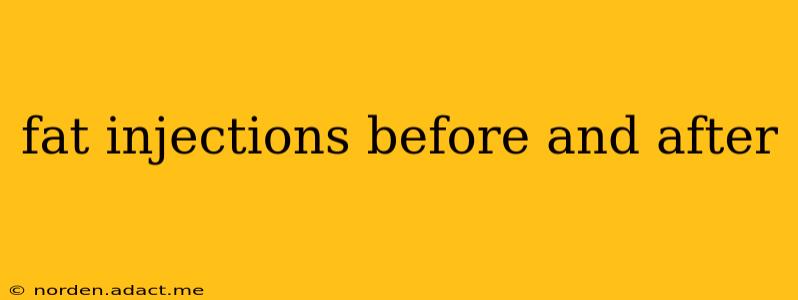Fat injections, also known as autologous fat grafting or fat transfer, are a cosmetic procedure involving the harvesting of fat from one area of the body and injecting it into another to add volume, improve contours, or enhance certain features. This minimally invasive technique has gained popularity for its natural-looking results and use of the patient's own tissue, minimizing the risk of allergic reactions. However, understanding the process, potential risks, and realistic expectations is crucial before considering this procedure.
What Happens Before a Fat Injection Procedure?
Before undergoing a fat injection procedure, a thorough consultation with a board-certified plastic surgeon or dermatologist is essential. This consultation will involve a detailed discussion about your goals, medical history, and current medications. The doctor will assess your suitability for the procedure, discuss potential risks and complications, and answer all your questions.
Key aspects of the pre-procedure consultation include:
- Medical History Review: This involves discussing any allergies, bleeding disorders, or other medical conditions that might affect the procedure's outcome or safety.
- Physical Examination: The doctor will examine the areas where fat will be harvested and injected, assessing the amount of fat available and evaluating the overall suitability of the procedure.
- Imaging (if necessary): In some cases, imaging techniques like ultrasound or CT scans may be used to better visualize the fat deposits and plan the procedure.
- Discussion of Expectations: It's crucial to discuss realistic expectations and understand that not all injected fat will survive. The doctor will help you manage your expectations and understand the potential for uneven results or the need for touch-up procedures.
- Pre-operative Instructions: The doctor will provide specific instructions regarding diet, medication, and activities to follow before the procedure. This may include avoiding blood-thinning medications or alcohol consumption.
What Happens During a Fat Injection Procedure?
The procedure typically involves these steps:
- Liposuction: Fat is harvested from a donor site (often the abdomen, thighs, or hips) using liposuction. A small incision is made, and a cannula (a thin, hollow tube) is inserted to gently remove fat cells.
- Fat Processing: The harvested fat is then processed to remove excess fluid and impurities. This purification process helps to improve the survival rate of the transplanted fat cells.
- Injection: The purified fat is injected into the targeted areas using fine needles or cannulas. The doctor carefully places the fat to achieve the desired aesthetic results.
- Post-Procedure Care: The injection sites are typically bandaged or covered to minimize swelling and bruising.
What are the Results Like After a Fat Injection?
The results of fat injections are gradual, with some swelling and bruising expected immediately following the procedure. This swelling usually subsides within a few weeks. The final results are typically visible after several months, as the transplanted fat cells gradually integrate into the surrounding tissue.
Expect:
- Improved volume and contours: Fat injections can effectively add volume to areas like the cheeks, lips, breasts, buttocks, or hands, improving their shape and overall appearance.
- Smoother skin: The injected fat can improve skin texture and reduce the appearance of wrinkles or scars.
- Natural-looking results: Because the procedure uses the patient's own fat, the results generally appear very natural.
What are the Potential Risks and Complications of Fat Injections?
While generally safe, fat injections carry potential risks and complications, including:
- Infection: Infection is a possibility with any surgical procedure.
- Swelling and bruising: These are common side effects that typically resolve within a few weeks.
- Fat necrosis: In some cases, the injected fat cells may die, resulting in lumps or nodules.
- Asymmetry: Uneven results are possible, requiring touch-up procedures.
- Calcification: In rare instances, calcium deposits can form at the injection site.
- Edema: Significant swelling, requiring more time to resolve.
- Pain: While largely tolerable, patients might experience some pain or discomfort.
How Long is the Recovery Time After Fat Injections?
Recovery time varies depending on the extent of the procedure and the individual's healing process. Most patients can return to their normal activities within a few days, but strenuous exercise should be avoided for several weeks. Swelling and bruising may persist for several weeks, and the final results are usually visible after several months. Follow-up appointments are typically scheduled to monitor healing and address any concerns.
How Much Does a Fat Injection Procedure Cost?
The cost of fat injections varies significantly depending on several factors, including the location of the clinic, the extent of the procedure, and the surgeon's fees. It's crucial to consult with several doctors to compare prices and understand what's included in the total cost.
Are Fat Injections Permanent?
Unfortunately, fat injections are not permanent. While a significant portion of the injected fat cells typically survive, some are reabsorbed by the body. The longevity of the results can vary depending on factors like the individual's metabolism, the injection site, and the surgeon's technique. Touch-up procedures may be necessary to maintain the desired results.
This information is for general knowledge and informational purposes only, and does not constitute medical advice. Always consult with a qualified medical professional for any health concerns or before making any decisions related to your health or treatment.
